wrestling / Columns
Going Broadway 03:27:12: The Night Bruno And Pedro Turned Out The Lights At Shea
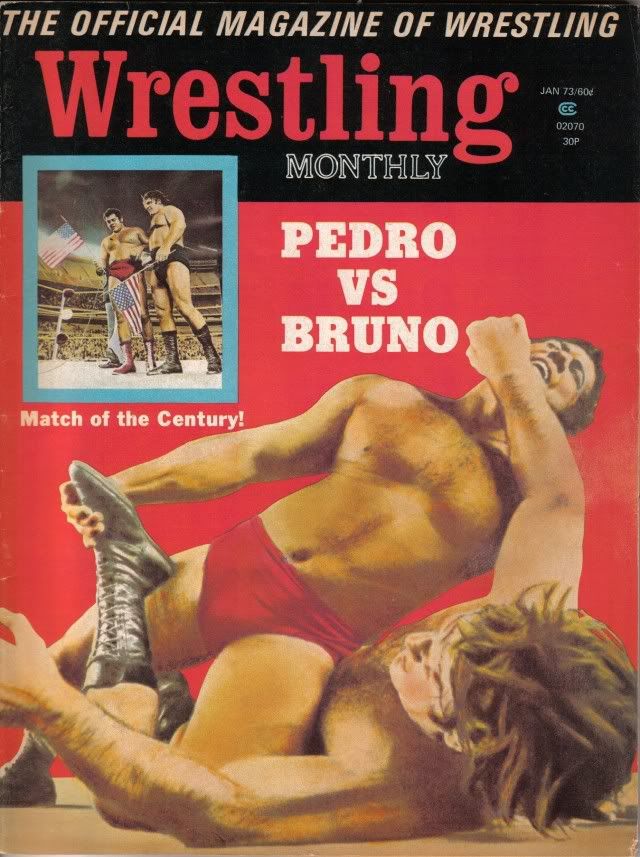
1972. WWWF televised event. Two of the biggest stars in the business teaming together for an epic tag team match. One, the current World Champion in Pedro Morales. The other, the former (and eight year reigning) World Champion, Bruno Sammartino. In our lifetime, it was like a Hogan and Warrior or an Austin and Rock team up. Their opponents, the heavy heels Professor Tanaka and Mr. Fuji. Without a doubt, the kind of tag team match where the fans expected the heels to get their comeuppance for their previous wrongdoings.
But then came a turn in the match. Fuji, in trademark fashion, threw salt into the eyes of Sammartino, blinding him into an inadvertent attack against Morales who came into the ring to help his partner. As Morales hit the mat, Tanaka followed Fuji’s play and blinded Morales with his own toss of salt. Suddenly, the two allies found themselves mistakenly battling each other, thinking they were Tanaka and Fuji. When the dust (or salt) settled, the match was clearly over, but the result created heat between Sammartino and Morales with each man blaming the other for the circumstances.
Vincent J. McMahon knew what he had on his hands. Something that had not been done in wrestling before. Two mega faces at odds with other. The perfect centerpiece for his outdoor event at Shea Stadium.
The Match Of The Century.
…
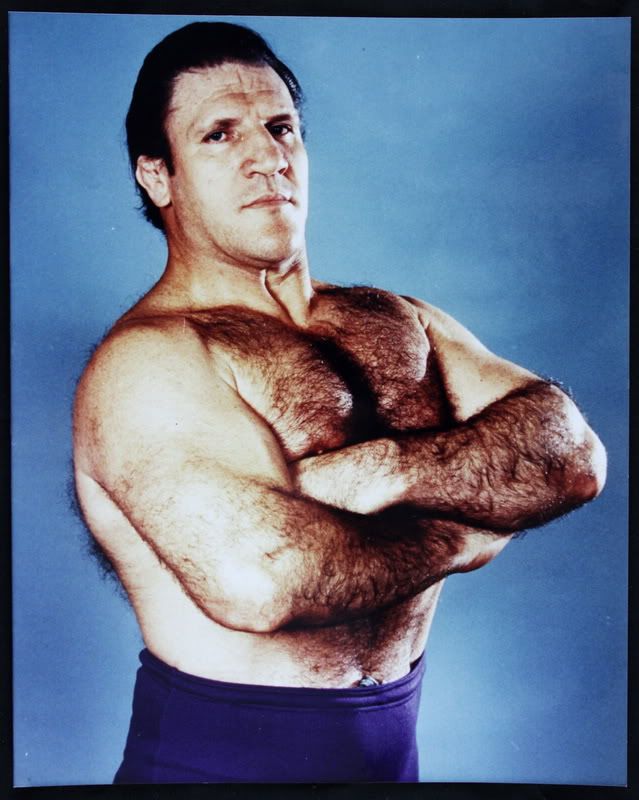
Born in 1935, Bruno Sammartino was an immigrant to America from Italy, whose family planted roots in Pittsburgh, PA in 1950. The teenage Sammartino, having already survived a life threatening battle with rheumatic fever, took on the hobby of weightlifting to build up his slender, gaunt frame.
Sammartino’s success in the weight room nearly earned him a spot on the 1956 US Olympic team, but he was edged out by eventual gold medalist in the ’56 games, Paul Anderson. But his impressive feats of strength, which became a sort of local event each time, caught the eye of a local wrestling promoter in the area who recruited Sammartino into his fold. Not only was Sammartino a specimen in terms of his 6’1″ 280 pound frame, but his Italian ethnicity was a draw to many of his fellow countrymen in the Pittsburgh area.
His first match was a 19 second squash of Dmitri Grabowski.
As a wrestler, Sammartino was an instant draw and was selling out the Civic Arena in Pittsburgh. But he would quickly extend his popularity beyond Pennsylvania when he began working Madison Square Garden in 1960. Again, Sammartino would instantly achieve a wave of popularity and became a main event draw in New York before the year was over. (It didn’t hurt that he was able to lift and slam the over 600 pound Haystacks Calhoun either.)
As foreshadowing to his eventual relationship with Vincent J’s son, Sammartino developed a strained relationship with the elder McMahon which stemmed from the obvious root of dissension in wrestling between performer and promoter in the form of broken promises and unfulfilled payouts. On a couple of occasions he would part with the WWWF for greener pastures (Toronto, for example), but would find his way back through various circumstances.
This was a significant time in the history of the WWWF with McMahon’s schism from the NWA and creation of his own World Champion in the form of Buddy Rogers. But the promotion stood on fragile legs and needed a popular face to ultimately bring legitimacy to the WWWF and put fans in the seats. McMahon knew Sammartino would be the answer to the latter, but it was Sammartino who negotiated a title run for himself if he was to return to the promotion.
A deal was reached, and Sammartino faced Rogers at the Garden with belt on the line. Supposedly the true finish of the match was not revealed to Rogers until he was in the ring with Sammartino, more specifically in a headlock by Sammartino. Allegedly Sammaritno said to him in the midst of his grip “We can do this the easy way or the hard way.” The match lasted all of 48 seconds with Sammartino getting the win via his submission. Rogers quickly exited the ring after doing things the easy way.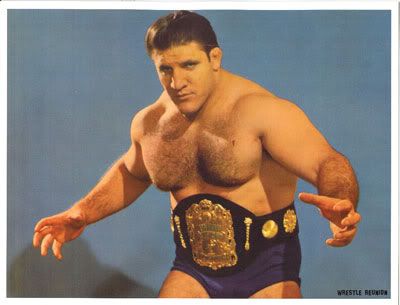
The resulting win began a record setting run for Sammartino as he would hold the WWWF Title for nearly eight years, a record that still stands today. Along the way he bested all of the top heels in the business from Killer Kowalski to Freddie Blassie to Gorilla Monsoon and set numerous attendance records at arenas. Sammartino was the no doubt the most popular wrestler in the country and became a living legend in the business.
However, as all good things must come to an end, so did Sammartino’s reign as champion. Having become exhausted from the workload of the last eight years, Sammartino dropped the belt in a shocking loss to Ivan Koloff; a finish that was so unexpected and jarring that the fans were silent in disbelief. Many were crying as the defeated Sammartino walked back to the dressing room.
But as the prophetic Yoda uttered in The Empire Strikes Back, “There is another.” And again it would come from foreign soil to take American wrestling by storm.
…
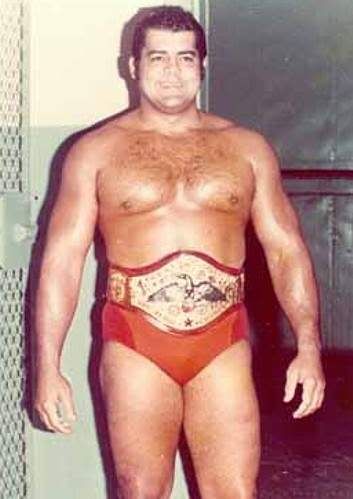
Born in 1942, Pedro Morales was a Puerto Rican immigrant who started his career in professional wrestling at the age of 17. Although his career began in New York, it was his move to Los Angeles that jump started his career in the business.
As a worker for the WWA promotion, Morales earned the respect of veterans with his technical proficiency as well as incredible endurance in the ring. In 1965, he defeated The Destroyer to become the WWA champion and would win it again that same year after a rematch with Luke Graham (who defeated him five months after his first title win).
After a nine month reign as champion in the singles ranks, Morales shifted to tag team action and became a four time tag team champion as well. In 1968, with WWA in the midst of organizational changes, Morales moved to Hawaii and resumed his prominence in the singles and tag team ranks, wining NWA titles for each in the territory.
The turning point in Morales’ career would come with signing with McMahon and the WWWF in 1970. As a natural baby face in the same vein as current champion Bruno Sammartino, Morales again was respected for his incredible physical abilities and brought yet another element of popularity to McMahon’s WWWF with his rapport with the Puerto Rican community. With Sammartino about to exit from the main event scene, McMahon needed another fan favorite to carry the torch.
The predicament he was faced was having one baby face defeat another, which was a taboo booking move in wrestling. Thus, Ivan Koloff, a mega heel at the time, was utilized as a transitional champion to take the belt off Sammartino, which would set up Morales for his championship match.
On February 8, 1971, Morales defeated Koloff at Madison Square Garden to become the fourth WWWF World Champion in its history much to the delight of Morales’ mega fan base in New York.
Morales would carry the torch as the face of the WWWF throughout 1971 and deep into 1972. However, despite the heavy fan base he carried in New York, Morales was unable to generate the same fanfare outside of the Garden. Although still a popular baby face champion, the WWWF again was slumping in attendance, and McMahon thought a significant main event match was needed to legitimize the championship reign of Morales to the fans.
Again, McMahon reached out to Sammartino.
“I had to take this match to prove I was a worthy champion, even though I didn’t want the pressure again.” – Bruno Sammartino from Ross Davies’ biography Bruno Sammartino
…
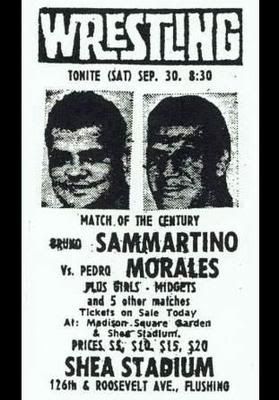
The planned show was an outdoor event to be showcased at Shea Stadium, which only six years previous had housed The Beatles to over 40,000 fans and only three years previous the World Series winning Mets. McMahon knew to bring the fans in he needed a main event that was as big as a heavyweight boxing bout. With the events having transpired in the tag match with Morales and Sammartino, the groundwork had been laid for such a battle.
The Showdown at Shea took place on September 30, 1972.
Over 22,000 fans braved a very cold and rainy day to see the match dubbed “The Match of The Century.” As we’ve all found throughout the years of watching mega events like this, how the fans will react can never be predicted. The usually heavy favored Sammartino was jeered by the fans, something he had not really encountered in his career as a wrestler.
Davies’ biography on Sammartino offers the suggestion that Sammartino was disliked that day because the fans “who attended the monthly cards at Madison Square Garden were angry that Bruno was no longer appearing on a regular basis. Morales had replaced him in their hearts.”
The match was a technical wrestling exhibition in every sense of the word, and showcased not only the incredible stamina of each individual but also the focus to tell a compelling story inside the ring.
After several near falls and an attempted run-in by George “The Animal” Steele, the match finally had to be called a draw after an incredible 75 minutes due to the curfew instituted in New York. Morales and Sammartino had not only gone Broadway but well beyond anything anyone had expected. At the conclusion of the bout, both Morales and Sammartino embraced, once again unified as a tag team as well as friends.
McMahon’s gross was close to $141,000 for the event which nearly became a record for an outdoor wrestling show. The initial response was positive and reflected in an influx in attendance but unfortunately began to wain with Morales still in the top spot throughout 1973. McMahon knew the inevitable course of action: he needed Sammartino back as champion.
Sammartino again had reservations, still remembering the strain of the heavy schedule he had during his first title reign, but finally reached an agreement with McMahon which would reduce his schedule and also provide some monetary compensation from ticket sales.
To get the belt back on Sammartino without going over on Morales, McMahon had Stan “The Man” Stasiak win the title from Morales on December 1, 1973. McMahon, fearing a riot if Stasiak defeated Morales in New York, chose Philadelphia, PA as the venue for the changing of the guard. Stasiak (like Koloff before him) was a transitional champion designed to hold the belt until Sammartino was ready to re-assume his spot at the top of the wrestling world.
Nine days later, December, 10, 1973, Sammartino defeated Stasiak in the main event at Madison Square Garden and would go on to hold the title for another four years. The fans were back in droves.
…
In the coming years, McMahon (and his son) would deliver two more Showdown at Shea events to New York in 1976 and 1980. The 1976 show had Sammartino successfully defending his WWWF Title against Stan Hansen, while the 1980 show famously pitted him in a cage match with his protege turned heel, Larry Zbysko,
Interesting note: the under card of the 1976 Showdown at Shea had Andre the Giant facing boxer Chuck Wepner, who was the inspiration for the film Rocky which would debut later that year in theaters. The fight itself would also be the inspiration for the match between Thunderlips (Hulk Hogan) and Rocky Balboa in Rocky III.
After his run as WWWF Champion, Morales left the company in 1974 and worked various promotions throughout the country until staging a comeback to the renamed WWF in 1980. Morales not only went on to win the tag titles with Bob Backlund (which had to be immediately forfeited because Backlund was World Champion and by the rules of the time could not hold more than one title) but also claimed the WWF Intercontinental Title after defeating Ken Patera in his old stomping grounds of Madison Square Garden. The win was significant for Morales because he became the first ever Triple Crown Winner in the history of the WWWF and WWF. He would wrestle for the company until 1987 when he finally retired from the ring, and was inducted into the WWF Hall of Fame in 1995.
Sammartino would retire from the WWF in 1980 but return in 1984. Although he worked a number of matches with his son, David, in tag team action, Sammartino did feud with both Macho Man Randy Savage and the Honky Tonk Man for the Intercontinental Championship before finally calling it quits in 1988.
Unfortunately, Sammartino’s relationship with the company would become more and more strained due to his criticisms over issues such as steroid use and questionable story lines. His outspoken position on the direction of the WWF/E has kept him out of the Hall of Fame as well as many other honorable mentions. (He is also missing from the past and present roster on the new website.)
There was almost a breakthrough in 2004 while in the midst of a possible DVD release of Sammartino’s greatest matches as well as a possible position working on WWE 24/7 Classics, but the negotiations fell through once again over the present direction of the company. The RAW that week was in Pittsburgh, and Sammartino was invited to attend but declined despite being told of the main event featuring Triple H and Chris Benoit. Sammartino added he would have attended if Benoit was wrestling Kurt Angle.
With Wrestlemania less than a week away, tons of great matches have been talked about and discussed and analyzed to death on this website. Granted, the Showdown at Shea was not a match that took place at Wrestlemania, but with the Rock-Cena match being billed as one that is “Once In A Lifetime,” it’s interesting to look back to a similar “Match of the Century” that took place during a time when the company was still on the verge of succeeding and failing with every event promoted and how two massive stars with two different fan bases produced wrestling history.
More Trending Stories
- Backstage Notes From Wrestle Kingdom 19 & Wrestle Dynasty, Travel Arrangements, Update on Contract Negotiations
- Tiffany Stratton in Pink, Isla Dawn, Jade Cargill Top This Week’s WWE Superstar Instagram Photos
- D-Von Dudley Reflects On Vince McMahon Using N-Word In Survivor Series 2005 Segment
- Triple H Says That Raw Leaving Monday Night Was Considered With Netflix Move







